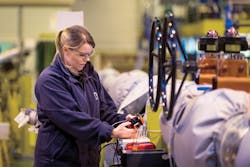In oil- and gas-producing regions, maintaining stable flow can be problematic for many reasons. Stable flow is believed to be crucial for accurate flow measurement, and good practice suggests that measurements should occur without instabilities or pulsations in the flow. Even minor inaccuracies can lead to significant financial exposure over extended periods of time. Given the high product value and throughput of most hydrocarbon production processes, a great deal of importance is placed on the accuracy of these measurements.
Sources of unstable flow can range from pressure fluctuations, intermittent flow or even the types of pumps that operate in the system. Other causes include declining oil production, increased water content or even incorrectly sized test separators. These sources can manifest themselves into variable flow, with frequency fluctuations of a range of magnitudes.
Change in conditions
In terms of oil flow measurement, turbine, Coriolis and ultrasonic flowmeters are the most commonly used flowmeters for the export of crude oil. However, as oil production declines, several changes are observed in the stability of the flow through these measurement technologies.
For the final export of oil streams from oil platforms, the content of water within the oil stream has been increasing. Furthermore, the amount of water content can vary significantly from one period to the next. This can result in unsuitable maintenance of flow stability and can manifest itself into sizable, low-frequency fluctuations in the flow rate.
Because export meters often measure the flow into common export pipelines, unstable flow rates from one source adversely affect the flow stability of other sources. This could occur via low-frequency fluctuations, which can distort the comingled flow and subsequently distort the flow rate at the source. Imagine an export pipeline with four different inputs: It is possible that if one source has a fluctuating flow, the stability of the other three inputs and the comingled flow could be altered.
While flowmeters are calibrated under steady-state flow conditions, many of them could operate under fluctuating flow. The stability of flow is important to ensure that accurate measurements are achieved during export measurement and meter calibration. In the past, fluctuating flow would have been deemed unacceptable for accurate measurement. However, because of declining oil production, aging assets and tightening budgets, fluctuating flow is increasingly common.
Although it has been identified as a potentially substantial issue, the effect of unsteady flow on different measurement technologies has not yet been fully investigated or examined. This is partly because research and calibration flow facilities calibrate flowmeters in ideal, steady flow conditions. Previously, achieving fluctuating flow for research was not required or desirable. Furthermore, the effect that fluctuating flow has on reference measurements means that a totalized mass or volume comparison would be required. This eliminates flow facilities that utilize pipe provers, compact provers or master meter systems. The most suitable reference system would require a weighbridge system for totalized mass and/or volume passed.
Filling the knowledge gap
While some limited research into the performance of turbine flowmeters in the presence of fluctuating flows has been conducted, public data are scarce. This is because performance in high-frequency and low-frequency fluctuations requires considerable investigation. Finding data on the performance of ultrasonic and Coriolis flowmeters is even more challenging. Hence a significant knowledge gap exists.
This article has so far focused on offshore oil and gas production, but fluctuating flow occurs in other areas of flow measurement. It is a common problem, but little evidence exists on the effects on flow measurement performance. While stable flow is believed to be crucial for accurate flow measurement, the industry has limited data for the performance of flowmeters under these conditions.
One option available is to complete a large-scale test program that evaluates a range of flowmeters under non-steady state conditions. This would allow a better understanding of the issues and provide quantitative evidence of flow measurement performance in unsteady flow. Flow fluctuations up to 0.1 hertz (Hz) can be created in a flow facility, enabling a host of flow measurement technologies such as turbine, Coriolis and ultrasonic flowmeters to be evaluated under unideal conditions. These could be cyclical, asymmetric and even random pulsations.
To evaluate the measurement performance of flowmeters such as turbine, ultrasonic and Coriolis devices when applied to fluctuating flow of varying frequencies, the flowmeters would first be calibrated at baseline steady-state conditions. Cyclic and asymmetric fluctuations as well as hold times and, if possible, random pulsations in the flow rate could cause different deviations in performance depending on the measurement technology applied.
Differential pressure devices such as orifice plates, Venturi devices and cone meters use the Bernoulli equation to determine the flow rate. Since the flow pressure would be strongly influenced by fluctuating flow, significant flow measurement errors are extremely likely. This body of work will provide conclusive evidence as to whether fluctuating flow is an issue for differential pressure technologies.
Where possible, the advanced flowmeter diagnostics from technologies such as Coriolis and ultrasonic flowmeters would be trended and analyzed with respect to unsteady flow. For example, ultrasonic flowmeters offer diagnostics that can provide measurements of parameters such as speed of sound, signal to noise ratio, flow velocity, alarm and failure indicator and velocity sampling interval, to name a few. It may be possible to use the advanced flowmeter diagnostics to indicate when fluctuating flow occurs as a qualitative measurement. Ideally, it may even be possible to correct for adverse effects on the measurement that may arise from fluctuating flow. While it is not possible to pre-empt the results of the test program, this is certainly an area that would be of great interest to industry.
Computational fluid dynamics (CFD) also offers potential uses for characterizing the effects of fluctuating flow. CFD validation of the experimental results from this project would allow for a direct comparison between experimental data and CFD model data. If the models are robust and can be fully validated, then CFD models could even be used to extrapolate the experimental test program. This could involve other meter designs, measurement technologies, fluid properties and even higher frequency fluctuating flow (\>10 Hz).
The results and knowledge acquired from this body of work would enable fluctuating flow to be mitigated wherever possible, for example, by the introduction of suitably designed flow dampeners. Another solution might be to select a measurement technology that appears unaffected by flow fluctuations.
Currently it is not possible to specify which technology might be the most appropriate because of the aforementioned lack of traceable data. Only by completing a thorough evaluation program will it be possible to identify the most suitable flow measurement technology.
The results would cover aspects such as fundamental accuracy and repeatability in the unstable flow environment and provide quantitative evidence concerning meter performance with respect to frequency changes in flow conditions. The impact of this would be to allow the replacement of some measurement techniques that are highly prone to mismeasurement because of fluctuating flow. The implementation of the research outputs would provide much greater confidence in measuring fluctuating flow. From a financial perspective, the work would allow far greater confidence in transactions.
Chris Mills is a project engineer at NEL. NEL is a world-class provider of technical consultancy, research, testing and program management services. Part of the TÜV SÜD Group, NEL is also a global center of excellence for flow measurement and fluid flow systems and is the U.K.’s National Measurement Institute for Flow Measurement. For more information, visit tuvnel.com.



